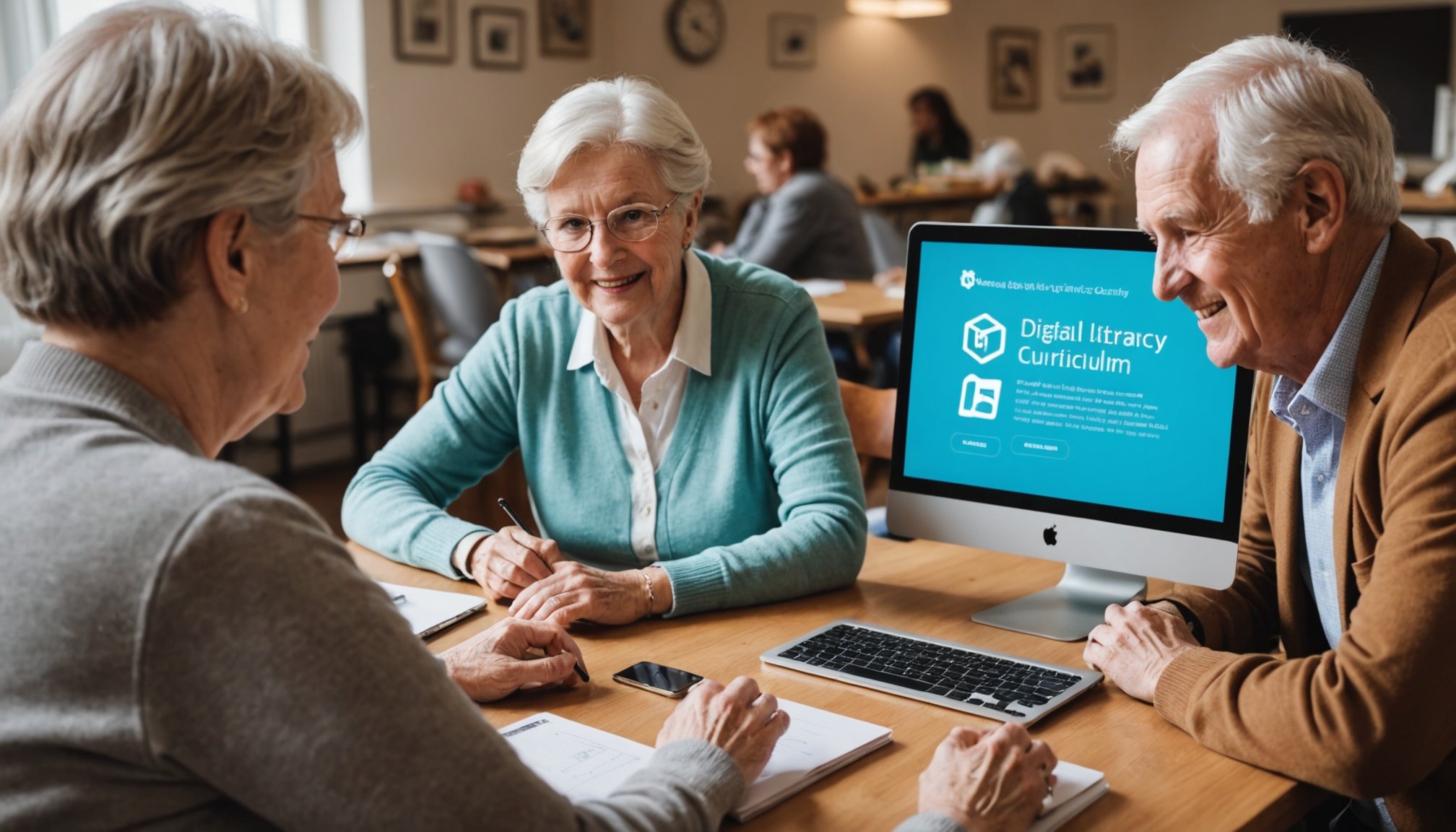Understanding the Needs of Seniors in Digital Literacy
Seniors often encounter unique challenges when navigating the digital world. These barriers can range from unfamiliarity with modern interfaces to physical limitations that hinder accessibility. Recognising the variety of technology challenges for seniors is imperative for fostering effective digital learning environments.
Understanding the levels of tech proficiency among older adults is equally crucial. Some seniors may only require assistance with basic tasks like sending emails or browsing the internet, whereas others might struggle with more advanced applications. This disparity necessitates a tailored approach to digital education programs, ensuring that resources are accessible and relevant to individual needs.
Also to see : Crafting Engaging Augmented Reality Advertising Strategies for UK Retailers
To effectively tackle these challenges, it is essential to employ strategies that assess and prioritise the needs of seniors. This involves assessing their current proficiency levels through surveys or interviews, allowing for a more customised learning experience. Additionally, incorporating user-friendly designs and providing ongoing support can significantly enhance accessibility in digital learning for seniors. By addressing these needs, we can empower seniors to engage confidently and safely with technology, bridging the digital divide one step at a time.
Defining Curriculum Goals for Seniors
Establishing a curriculum that meets the unique needs of seniors is crucial for successful digital education. Tailoring learning outcomes to seniors’ interests ensures the content is engaging and relevant. What specifically are effective curriculum goals for this demographic?
Also read : Mastering the Art of Opening a Specialty Coffee Shop in the Countryside of the UK
It’s essential to align objectives with practical applications that match seniors’ daily lives. For instance, teaching them how to use smartphones for video calls can significantly improve their ability to stay connected with family and friends. Similarly, introducing online banking can enhance their financial management skills.
Let’s consider some measurable outcomes. A crucial aim is to gauge seniors’ proficiency in digital literacy. This can be assessed through tasks like efficiently navigating a web browser or sending an email. Completing these tasks indicates a foundational understanding of necessary technological skills.
By creating objectives in digital education that focus on these practical tasks, educators can ensure that the learning process is both beneficial and enjoyable. This approach promises not only to enhance seniors’ comfort with technology but also to empower them as confident and informed digital citizens.
Choosing Effective Instructional Methods
Exploring instructional methods for seniors requires a unique blend of approaches to enhance both engagement and learning retention. Older adults often benefit significantly from teaching techniques that leverage their life experiences, providing context and relevance in lessons. Techniques such as storytelling or using real-life scenarios can anchor new knowledge to existing frameworks, making assimilation smoother.
Hands-on learning is particularly effective, as it allows seniors to actively participate and practice what they’ve learned. This approach can be supported by peer collaboration, which not only reinforces concepts but also builds a sense of community and support. Engagement strategies like this not only encourage participation but also enrich the learning environment with diverse perspectives.
Moreover, utilizing familiar contexts and materials is crucial for maintaining interest and aiding memory. For example, tailoring activities around daily routines or hobbies can make learning feel more relatable and less daunting. Engaging seniors with content that reflects their interests and experiences can lead to more meaningful interactions and a better educational experience.
Ultimately, refining instructional methods for seniors requires a delicate balance of respect for their accumulated knowledge and the introduction of new concepts in an engaging, accessible manner.
Designing Accessible Learning Resources
Creating digital learning resources that cater to diverse needs, particularly for seniors, requires careful consideration of their usability and accessibility. These resources, including videos, handouts, and educational software, are essential in fostering digital literacy among seniors and empowering them to engage confidently with technology.
Types of Resources
-
Videos: Visual aids can significantly enhance understanding. Ensure they have clear audio and options for subtitles or captions. This accommodation supports seniors with hearing difficulties.
-
Handouts: Printed materials should use a large, readable font size and include visuals that illustrate key concepts, aiding those with visual impairments.
-
Educational Software: User-friendly interfaces are crucial. Look for software with simple navigation and features that allow personalized settings, such as larger text displays or voice commands.
Considerations for Accessibility
When crafting accessible materials, ensure font sizes are adjustable, and information is structured in a direct and intuitive manner. Visual elements, such as icons or diagrams, should be clear and relevant. These considerations are pivotal in creating resources that are easily navigable.
Recommendations for Tools
Several free and affordable technology tools are suitable for seniors. These include applications like Zoom for video communication, DuoLingo for language learning, and simple calculators or e-books with adjustable font settings. Each tool emphasizes ease of use while enhancing the digital experience efficiently.
Developing Assessment Strategies
In digital education, especially for seniors, effective assessment in education is crucial. Evaluating digital skills both before and after the curriculum helps in measuring progress and tailoring learning experiences. Pre-assessment techniques might include digital literacy tests or interviews to understand learners’ baseline skills. This initial evaluation is essential for setting achievable goals and identifying areas that need extra attention.
Throughout the learning process, feedback techniques become vital. Ongoing feedback not only keeps learners motivated but also helps in making necessary adjustments to teaching strategies. Techniques such as regular quizzes, peer reviews, or informal discussions can be beneficial in maintaining engagement and tracking progress.
Formative assessment methods focus on providing real-time feedback during the learning journey. These might include quizzes, interactive activities, or self-assessment tools that enable learners to understand their own growth. On the other hand, summative assessments are conducted after the completion of a course to evaluate the overall effectiveness. This can involve comprehensive tests or practical tasks demonstrating the ability to apply learned digital skills.
Support and feedback throughout these assessments ensure a holistic development approach, enabling seniors to master digital skills effectively and confidently.
Implementing the Curriculum
Successfully launching a digital literacy program involves several essential steps. Initially, identifying the objectives of the program is crucial. This helps in tailoring a curriculum that fits the specific learning needs of the seniors. Early and effective curriculum implementation involves mapping out realistic timelines and structured content delivery.
A significant element to consider is the training delivery. This includes preparing instructors and volunteers to engage effectively with senior learners. Training should focus on patience, clarity, and the ability to simplify concepts. Instructors should understand the nuances of influencing adult learning and apply techniques that encourage participation and retention.
Creating a supportive community environment is also vital. Learners benefit immensely from an inclusive and collaborative atmosphere. Establishing peer-learning sessions and regular feedback mechanisms help reinforce knowledge and build confidence among participants.
To ensure program execution aligns with expectations, continuous assessment and feedback loops are important. Facilitators can make data-driven decisions to adjust the program where necessary. This adaptive approach fosters a dynamic learning experience. Engaging senior learners requires understanding and patience, but with a well-structured plan, the rewards are mutual and significant. By focusing on these key areas, a digital literacy program has a good foundation for success.
Highlighting Examples of Successful Programs
Successful digital literacy programs in the UK serve as exemplary models for empowering seniors in the digital age. These initiatives focus on enhancing technological competence and fostering a long-lasting impact on communities. Analyzing case studies provides valuable insights into how these programs achieve their goals and establish best practices.
One notable program, “Tech Savvy Seniors”, demonstrates success by combining professional digital training with active community involvement. By partnering with local libraries and community centers, the program provides seniors with easy access to digital literacy workshops. This approach not only enhances their skills but also builds a supportive network that encourages continuous learning.
Community involvement plays a pivotal role in the success of these initiatives. By engaging community members as volunteers, programs like “Silver Surfers” harness local knowledge and camaraderie, creating an inviting atmosphere conducive to learning. Volunteers often offer personal experiences and tailored guidance, facilitating better understanding and retention for participants.
Ultimately, these case studies highlight the importance of a tailored approach, where cultivating a sense of belonging and community engagement is integral to successful digital literacy programs. By drawing from such examples, future initiatives can incorporate these best practices to effectively meet the needs of senior citizens.
Addressing Challenges and Solutions
Navigating the digital realm can be daunting for seniors, with challenges in digital literacy often resulting in frustration and hesitancy. Common barriers include a lack of familiarity with technology, fear of making mistakes, and limited access to resources. These obstacles can make it difficult for seniors to fully engage with digital tools and services.
To overcome these barriers, it is essential to implement solutions for seniors that address their unique needs. Tailored educational programs that focus on basic computer and internet skills can significantly improve their understanding and confidence. Personalized, step-by-step tutorials and workshops can make learning less intimidating, fostering an environment of encouragement and positivity.
Moreover, incorporating patience and empathy in teaching methods is crucial. Encouraging resilience and confidence in technology use among seniors requires a supportive approach that celebrates small successes and promotes continuous learning. Providing easy-to-use devices and accessible applications can also enhance the learning experience and strengthen seniors’ digital skills.
By addressing these challenges with thoughtful solutions, seniors can become more adept in embracing the digital world, thus enhancing their independence and quality of life.







